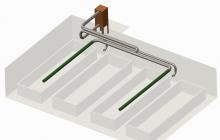Controlling Exposures in Livestock Production
As part of the Great Plains Center for Agricultural Health(GPCAH), we are working on evaluating the feasibility of reducing exposures in concentrated animal feeding operations (CAFO) to protect agricultural workers' health. In the Midwest, it is common to significantly reduce the amount of fresh air brought into livestock buildings because heating this fresh air is expensive. This project hypothesizes that traditional industrial ventilation equipment and design can be used to improve the air quality in a swine farrowing operation to reduce worker exposures to hazardous dusts and gases in the winter. We are evaluating changes in room concentration when we exhaust room air, treat the air with commonly available air pollution equipment, and then return the treated air into the building. This work is funded by NIOSH / CDC as the intervention project for the GPCAH (U54 OH007548). More information is available at https://www.public-health.uiowa.edu/gpcah/center-projects/intervention-to-reduce-exposures-in-cafos/.
This project includes mathematical modeling (using Simulink, an add-on package to MatLab software) to perform initial feasibility analyses. This work was used to optimize the flowrate through the air pollution control equipment and determined the effects of diluting this treated air with cold, clean, outside air. This work formed the basis for field intervention project, 2013-2016. Current work is optimizing the simulation model to allow estimation of room concentrations, for contaminants including dust, ammonia, carbon dioxide, to be modeled by producers in the Midwest. Articles from this phase of the project include:
-
Park JH, Peters TM, Altmaier R, Sawvel RA, Anthony TR. (2013) Simulation of air quality and cost to ventilate swine farrowing facilities in winter. Journal of Computers and Electronics in Agriculture, 98: 136-145. [PMC4756655]
-
Anthony TR, Park JH, Altmaier R, Peters TM. (2014) Modeled effectiveness of ventilation with contaminant control devices on indoor air quality in swine farrowing facility. Journal of Occupational and Environmental Hygiene, 11(7): 434-449. [PMC4753559]
-
Park J, Peters TM, Altmaier R, Jones SM, Gassman R, Anthony TR (2017). Simulation of air quality and operational cost to ventilate swine farrowing facilities in Midwest U.S. during winter. Transactions of the ASABE, 60(2):465-477. [link]
The second arm of this project involved bench and field testing of air pollution control devices in a swine farrowing barn. Initial studies evaluated the effectiveness of no new system, in order to obtain baseline measurements in our test barn. This work confirmed that the manure pit fans, when operating in the wintertime, were successful at reducing hazardous concentrations, but not sufficiently below industry guidelines. Next, a filtration system was installed at the test site and its performance was tested over a winter season. This work identified that the unit was successful in reducing dust concentrations and that the increased airflow did not increase the concentrations of hazardous gases (ammonia, hydrogen sulfide, carbon dioxide) in the room. During this first intervention test, we identified a significant carbon dioxide concentration: we are also evaluating whether the style of room heater can be changed to reduce carbon dioxide to safer concentrations. Along with testing the heater intervention, the 2014-15 winter season was used to evaluate the effectiveness of a second air pollution control unit (cyclone). Continued evaluation of the effect of the new ventilated heater was performed in 2015-16 winter season. Articles from this phase of the project include:
- Peters TM, Anthony TR, Taylor C, Altmaier R, Anderson K, O’Shaughnessy PT. (2012) Distribution of particle and gas concentrations in swine gestation confined animal feeding operations. Annals of Occupational Hygiene, 56(9): 1080-1090. [PMC4777339]
- Reeve KA, Peters TM, Anthony TR. (2013) Wintertime factors affecting contaminant distribution in a swine farrowing room. Journal of Occupational and Environmental Hygiene, 10: 287-296. [PMC4753562]
- Peters TM, Sawvel R, Park JH, Anthony TR. (2015) Evaluation of a Shaker Dust Collector for Use in a Recirculating Ventilation System. Journal of Occupational & Environmental Hygiene. 12(9): D201-210. [PMC4753559]
- Anthony TR, Altmaier R, Jones S, Gassman R, Park JH, Peters TM. (2015) Use of recirculating ventilation with dust filtration to improve wintertime air quality in swine farrowing room. Journal of Occupational and Environmental Hygiene, 12(9): 635-646. [PMC4756717]
- Anthony TR, Yang A, Peters TM. (2017): Assessment of interventions to improve air quality in a livestock building. Journal of Agricultural Safety and Health, 23(4):247-263
